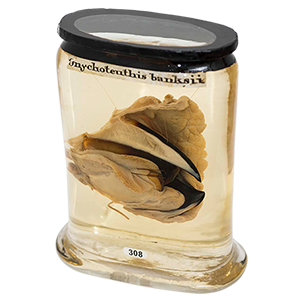 Unappetizing as it may look, this decontextualized lump is a food object in more ways than one. Members of James Cook’s Endeavour expedition, which circumnavigated the globe from 1768 to 1771, reportedly found the massive squid that this beak once belonged to floating in the ocean somewhere at the edge of the world between Cape Horn and Australia. And they did what many a naturalist would do when faced with a specimen: they ate it.
Unappetizing as it may look, this decontextualized lump is a food object in more ways than one. Members of James Cook’s Endeavour expedition, which circumnavigated the globe from 1768 to 1771, reportedly found the massive squid that this beak once belonged to floating in the ocean somewhere at the edge of the world between Cape Horn and Australia. And they did what many a naturalist would do when faced with a specimen: they ate it.